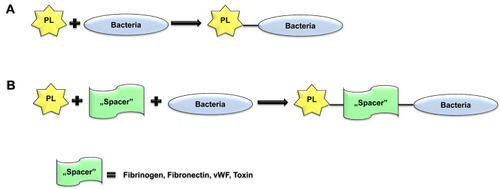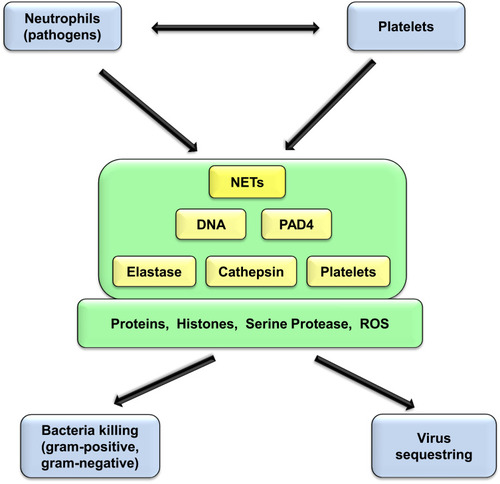Figures & data
Table 1 Diversity of Bacteria and Fungi Inhabiting Human Body
Figure 1 Use of plasminogen by bacteria for the production of plasmin, serine protease by bacterial SK or by host plasminogen activators eg u-PA and t-PA, which is released from ECs. The formed plasmin participates in the degradation of fibrin clot as well as laminin, fibronectin and type IV collagen and other components of ECM, which leads to the spread of bacteria through tissue barriers.
Abbreviations: SK, streptokinase; u-PA, urokinase plasminogen activator; t-PA, tissue plasminogen activator; ECs, endothelial cells; ECM, extracellular matrix.

Figure 2 Direct or indirect adhesion of bacteria to platelets. (A) Direct biding of bacteria via GPIIb-IIIa or GPIb (α-β) exposed on platelet surface. (B) Indirect binding of bacteria via spacer like fibrinogen or fibronectin and GPIIb-IIIa but also GPIb (α-β) via vWF. Platelets may also bind bacteria by gC1qR or/and CD62P receptors exposed on the platelet surface. Another “spacer” that binds bacteria to platelets is IgG delivered by bacteria through the FcγRIIa receptor present on platelets.
Abbreviations: PL, platelets; GP, glycoprotein; vWF, von Willebrand factor; IgG, immunoglobulin G.

Figure 3 The formation of NETs in response to infection is associated with the interaction of platelets with neutrophils containing cathepsin, DNA and protein components such as histones and serine proteases, PAD4, elastase and others. ROS also participate in NETs formation.
Abbreviations: NETs, neutrophil extracellular traps; DNA, deoxyribonucleic acid; PAD4, peptidylarginine deiminase type 4; ROS, reactive oxygen species.

